LEAF BEETLES
(April)
(April)
LEAF beetles are a very large family of beetles with much diversity of form, size and colour. Typically they are hairless, broadly oval when seen from above and rounded when seen from the side. Some species are cylindrical and elongate whereas others resemble ladybirds – they can be distinguished by the fact that ladybirds have three clearly visible tarsal (‘foot’) segments whereas leaf beetles appear to have four.
Many are brightly coloured or have a metallic sheen – conspicuous colouration, which often warns predators that the beetles are unpalatable (producing noxious compounds or using plant toxins from their diet).
Adults and larvae of all species are herbivorous and the evidence of a damaged food plant can often enable you to spot a leaf beetle! The adults mainly graze or chew flowers or foliage while the grub-like, short legged larvae either feed externally or mine and bore through leaves, stems and roots.
Many species are serious pests e.g. the notorious Colorado Potato Beetle. Two species that can be found in the Loughborough area are the Dock Leaf Beetle Gastrophysa viridula (e.g. on the edge of Gorse Covert wood) and the Viburnum Leaf Beetle ( Mount Grace Road, near the bridge, on the edge of Stonebow Washlands).
 The Dock Leaf Beetle (photo 1) is found in damp meadows or wastelands and also along field tracks or in gardens. The beetle, 4 – 6 mm in length, has metallic colouring – its elytra (wing cases) are usually green, although coppery and golden-green shades can be found, with the underside of its body a metallic black. Adults emerge from hibernation in the spring and locate their host plants – larvae and adults feed on Docks and related species (Rumex) – both bite holes in the leaves, whose blades are quickly reduced in size and riddled with perforations so that their presence is obvious even from a distance.
The Dock Leaf Beetle (photo 1) is found in damp meadows or wastelands and also along field tracks or in gardens. The beetle, 4 – 6 mm in length, has metallic colouring – its elytra (wing cases) are usually green, although coppery and golden-green shades can be found, with the underside of its body a metallic black. Adults emerge from hibernation in the spring and locate their host plants – larvae and adults feed on Docks and related species (Rumex) – both bite holes in the leaves, whose blades are quickly reduced in size and riddled with perforations so that their presence is obvious even from a distance.
Fertilised females become gravid (photo 2) – the abdomen is swollen with several hundred yellow eggs, which are laid in batches (20 – 45 eggs) on the underside of Dock leaves. The black larvae emerge within a week, feeding in small groups on the underside of leaves (photo 3)
yellow eggs, which are laid in batches (20 – 45 eggs) on the underside of Dock leaves. The black larvae emerge within a week, feeding in small groups on the underside of leaves (photo 3)  and when fully grown descend to the ground to pupate. There is more than one generation per year and adults can be found until the autumn.
and when fully grown descend to the ground to pupate. There is more than one generation per year and adults can be found until the autumn.
Many are brightly coloured or have a metallic sheen – conspicuous colouration, which often warns predators that the beetles are unpalatable (producing noxious compounds or using plant toxins from their diet).
Adults and larvae of all species are herbivorous and the evidence of a damaged food plant can often enable you to spot a leaf beetle! The adults mainly graze or chew flowers or foliage while the grub-like, short legged larvae either feed externally or mine and bore through leaves, stems and roots.
Many species are serious pests e.g. the notorious Colorado Potato Beetle. Two species that can be found in the Loughborough area are the Dock Leaf Beetle Gastrophysa viridula (e.g. on the edge of Gorse Covert wood) and the Viburnum Leaf Beetle ( Mount Grace Road, near the bridge, on the edge of Stonebow Washlands).
 The Dock Leaf Beetle (photo 1) is found in damp meadows or wastelands and also along field tracks or in gardens. The beetle, 4 – 6 mm in length, has metallic colouring – its elytra (wing cases) are usually green, although coppery and golden-green shades can be found, with the underside of its body a metallic black. Adults emerge from hibernation in the spring and locate their host plants – larvae and adults feed on Docks and related species (Rumex) – both bite holes in the leaves, whose blades are quickly reduced in size and riddled with perforations so that their presence is obvious even from a distance.
The Dock Leaf Beetle (photo 1) is found in damp meadows or wastelands and also along field tracks or in gardens. The beetle, 4 – 6 mm in length, has metallic colouring – its elytra (wing cases) are usually green, although coppery and golden-green shades can be found, with the underside of its body a metallic black. Adults emerge from hibernation in the spring and locate their host plants – larvae and adults feed on Docks and related species (Rumex) – both bite holes in the leaves, whose blades are quickly reduced in size and riddled with perforations so that their presence is obvious even from a distance.Fertilised females become gravid (photo 2) – the abdomen is swollen with several hundred
 yellow eggs, which are laid in batches (20 – 45 eggs) on the underside of Dock leaves. The black larvae emerge within a week, feeding in small groups on the underside of leaves (photo 3)
yellow eggs, which are laid in batches (20 – 45 eggs) on the underside of Dock leaves. The black larvae emerge within a week, feeding in small groups on the underside of leaves (photo 3)  and when fully grown descend to the ground to pupate. There is more than one generation per year and adults can be found until the autumn.
and when fully grown descend to the ground to pupate. There is more than one generation per year and adults can be found until the autumn. The Viburnum Leaf Beetle (photo 4)  is 5–6 mm in length, greyish- brown in colour and surprisingly difficult to see on its food plant. It can be a serious pest of Viburnum or Guelder Rose, often having a devastating effect on this shrub, reducing foliage to a lacework of damaged leaves (photo 5, late May 2008 in Mount Grace Road – how many larvae can you spot?).
is 5–6 mm in length, greyish- brown in colour and surprisingly difficult to see on its food plant. It can be a serious pest of Viburnum or Guelder Rose, often having a devastating effect on this shrub, reducing foliage to a lacework of damaged leaves (photo 5, late May 2008 in Mount Grace Road – how many larvae can you spot?).
The species over-winters, as eggs placed in small pits in the bark of the Viburnum stems, which hatch in May to release greenish-yellow larvae, which start to skeletonize foliage, usually starting with lower leaves and leaving only midribs and major veins intact.
As larvae mature, they darken and develop a series of dark spots (photo 6), before pupating in the soil. Adults emerge in late summer and evidence of their feeding damage is irregular and circular (photo 4, October 2007). When disturbed the beetles usually drop quickly to the ground. There is one generation per year.
before pupating in the soil. Adults emerge in late summer and evidence of their feeding damage is irregular and circular (photo 4, October 2007). When disturbed the beetles usually drop quickly to the ground. There is one generation per year.
 is 5–6 mm in length, greyish- brown in colour and surprisingly difficult to see on its food plant. It can be a serious pest of Viburnum or Guelder Rose, often having a devastating effect on this shrub, reducing foliage to a lacework of damaged leaves (photo 5, late May 2008 in Mount Grace Road – how many larvae can you spot?).
is 5–6 mm in length, greyish- brown in colour and surprisingly difficult to see on its food plant. It can be a serious pest of Viburnum or Guelder Rose, often having a devastating effect on this shrub, reducing foliage to a lacework of damaged leaves (photo 5, late May 2008 in Mount Grace Road – how many larvae can you spot?).
The species over-winters, as eggs placed in small pits in the bark of the Viburnum stems, which hatch in May to release greenish-yellow larvae, which start to skeletonize foliage, usually starting with lower leaves and leaving only midribs and major veins intact.
As larvae mature, they darken and develop a series of dark spots (photo 6),
 before pupating in the soil. Adults emerge in late summer and evidence of their feeding damage is irregular and circular (photo 4, October 2007). When disturbed the beetles usually drop quickly to the ground. There is one generation per year.
before pupating in the soil. Adults emerge in late summer and evidence of their feeding damage is irregular and circular (photo 4, October 2007). When disturbed the beetles usually drop quickly to the ground. There is one generation per year.




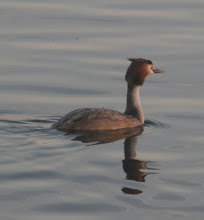
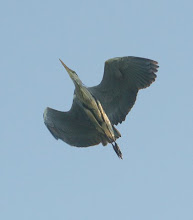
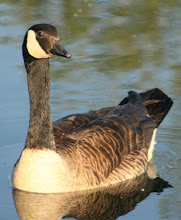
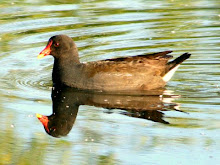
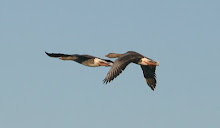
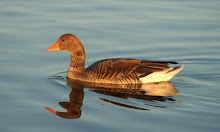

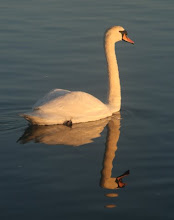
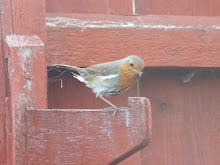
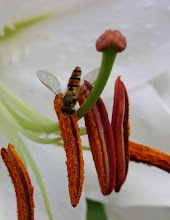
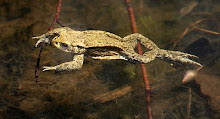



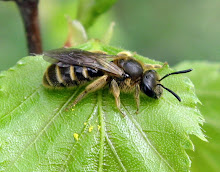
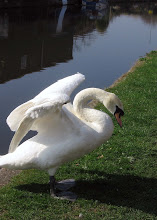
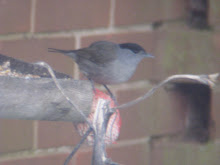
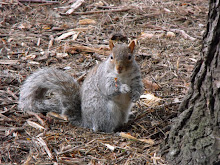
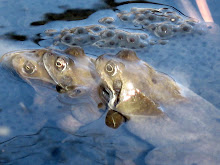
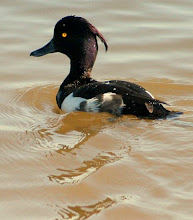
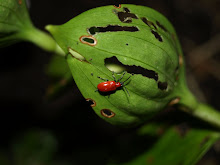
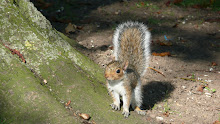
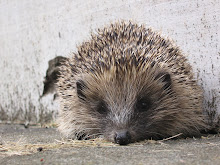
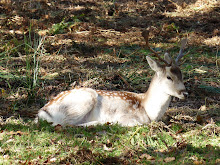
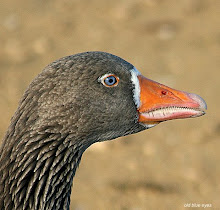
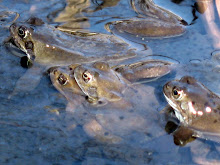
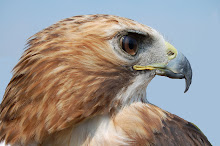
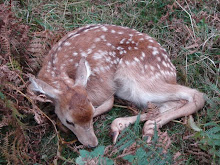






















No comments:
Post a Comment